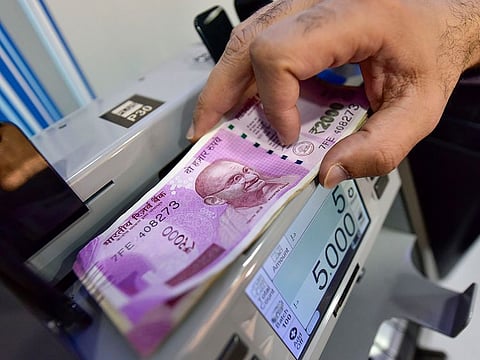At 22.69/Dh, India rupee stable after RBI leaves interest rate unchanged for 5th time
At 22.69 to Dh, Indian rupee remains at quite favorable levels for NRI remittances

Dubai: The Indian rupee maintained its stable levels of recent weeks after the central bank decided to leave interest rates unchanged for a fifth successive time. The rupee is trading at 22.69 to the dirham, and market watchers are not expecting any major shifts before the year-end.
The current levels are rated as comfortable enough for India's export prospects, and what that would mean for the overall economic growth prospects. India will close the year with one of the highest growth rates in the world.
Early on Friday (December 8), the Reserve Bank of India kept the repo rates at 6.5 per cent. (India's inflation dropped to 4.87 per cent in October, a four-month low.)
"Apart from one day last month, the INR has been range-bound against the dirham/dollar for some time now," said Neelesh Gopalan, Senior FX analyst at a Dubai fintech. "Even after last week's state elections and the decisive wins for the BJP in three results, the rupee kept to a stable track."
Where the action is really taking place is on the India stock markets, with the main BSE up by more than 300 points to just a shade under 70,000.
The Indian economy is poised to become the 3rd largest in the world by 2030 and we expect the momentum in growth rates to continue at around 6.8-6.9 per cent in 2024-25.

"The increase in forex inflows, the relative stability in crude oild price, and receding inflation indicators points out to limiting the INR downside," said Krishnan Ramachandran, CEO of Barjeel Geojit Financial Services. "The INR in the near term may see 83.75 levels (currently at 83.36) to the dollar and projections for 2024 indicate a range between 84.50-84.75.
"The Indian economy is poised to become the 3rd largest in the world by 2030 and we expect the momentum in growth rates to continue at around 6.8-6.9 per cent in 2024-25."
When will India start cutting interest rates?
The chances are that RBI could initiate the first one by April next, and which would be ahead of the next general elections. For that, the inflation might need to drop further from the 4.87 per cent in October. That itself was a 4-month low.
If we consider the present trends, the India housing market is on a bull run and unchanged home loan rates will only add to the overall positive consumer sentiments.

Another positive for India property
Where the unchanged lending rate will make its presence felt is in India's real estate space. "This (the no rate hike decision) is an extension of the festive bonanza that RBI gave to the homebuyers in its last policy announcement," said Anuj Puri, Chairman of the real estate consultancy Anarock. "It gives homebuyers yet another opportunity to make cost-optimized home purchases.
"If we consider the present trends, the India housing market is on a bull run and unchanged home loan rates will only add to the overall positive consumer sentiments. Additionally, given that housing prices have escalated across the Top 7 cities in the last one year, at least the unchanged home loan rates will give some relief to the homebuyers."
The RBI's decision to maintain unchanged interest rates reflects a cautious approach aimed at stabilizing inflation within the targeted band of 2-6%. Notably, the RBI governor mentioned a balanced risk outlook, and the projection for real GDP growth stands at 7% for the current fiscal year, with an anticipated range of 6.4-6.9% for the nextAshwin Chadha, CEO, India Sotheby's International Realty
Retail, auto sales will continue good run
Apart from new home sales, the Indian consumer confidence is showing up across sectors, with retail and automotive sales major beneficiaries. "While no one was expecting the RBI to start cutting rates now, the assurance of keeping rates steady itself is a boost for spending by consumers and businesses," said an analyst. "We can see that all the way through to March end, which is the financial year end."
Sign up for the Daily Briefing
Get the latest news and updates straight to your inbox



